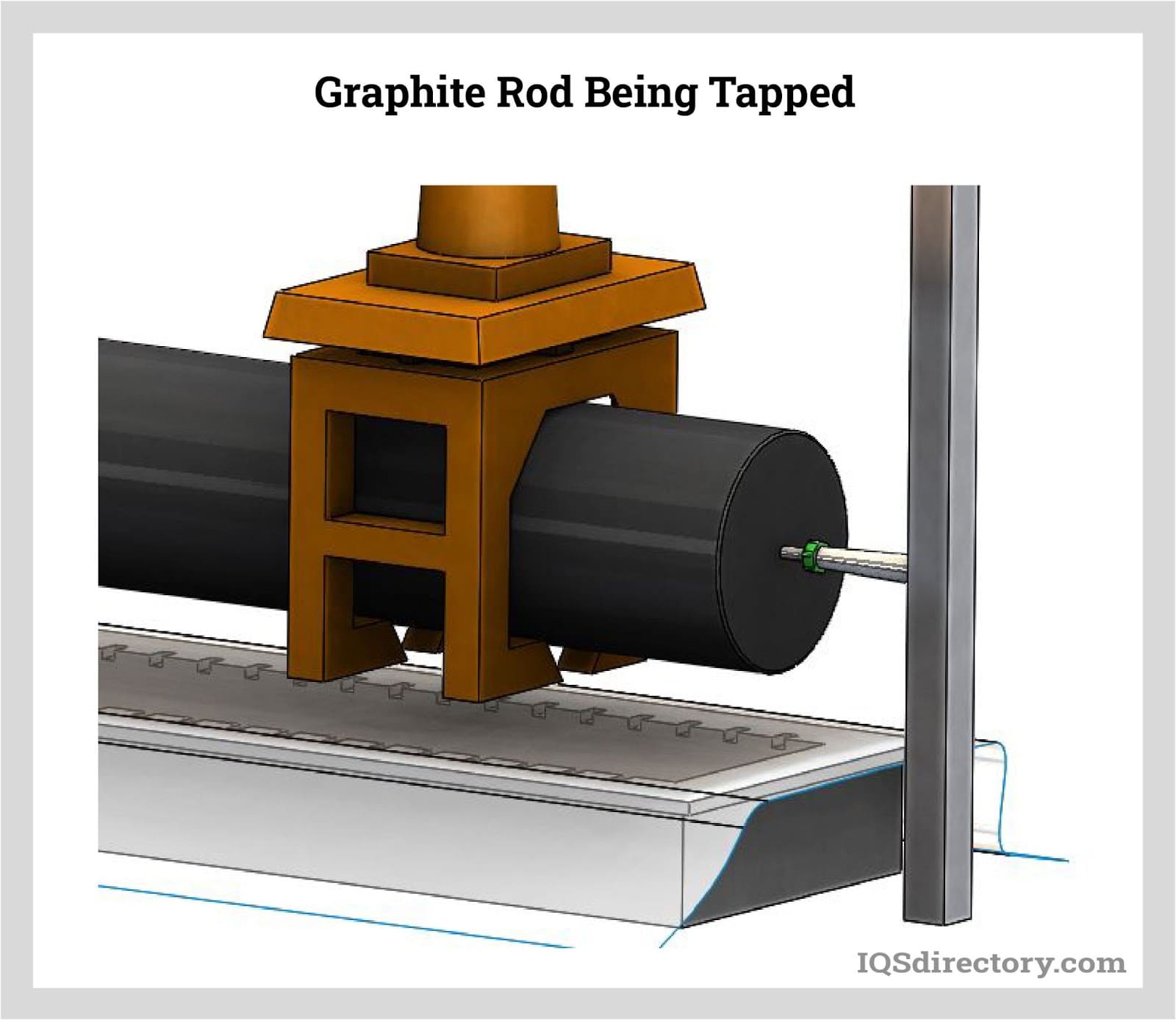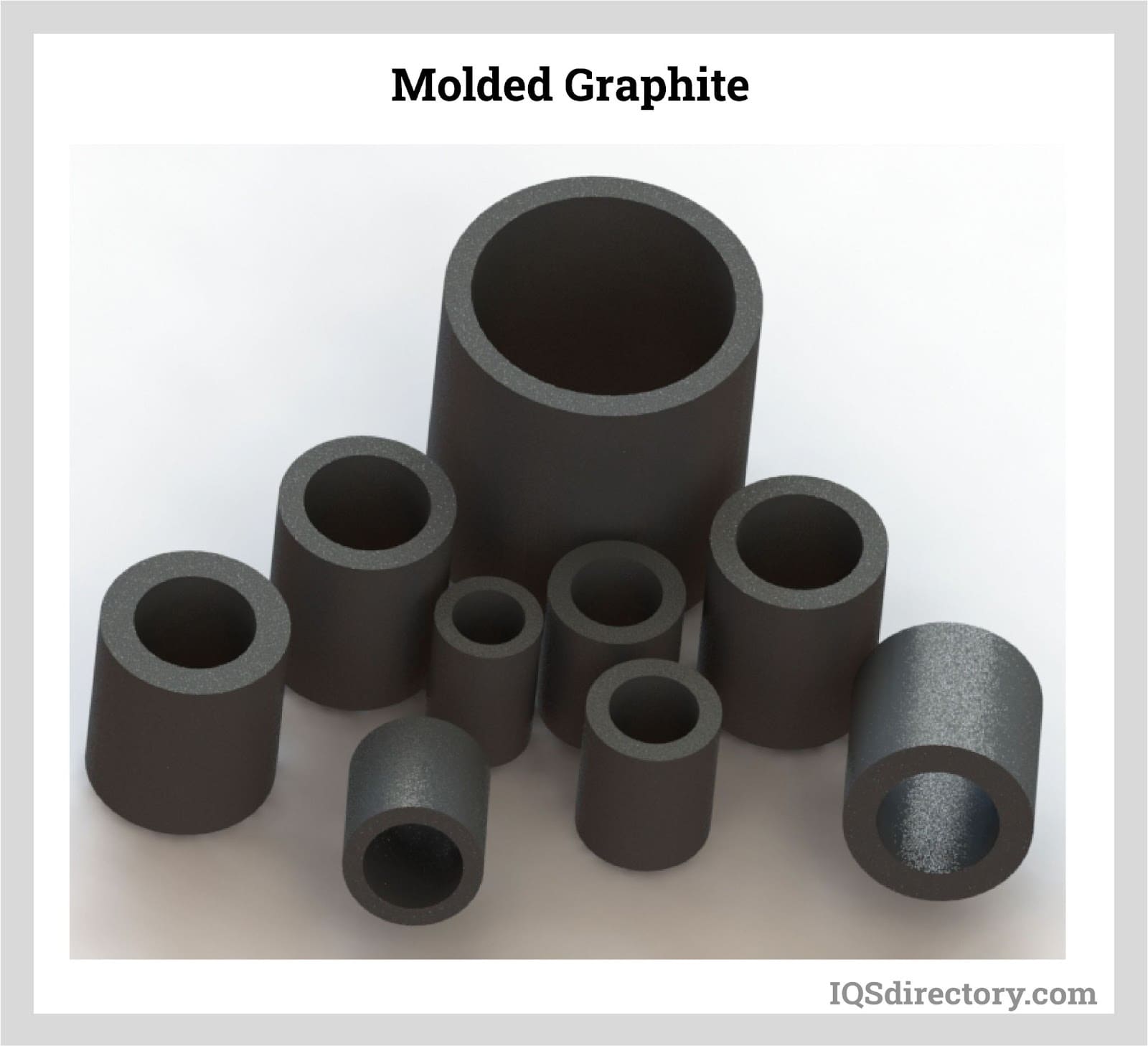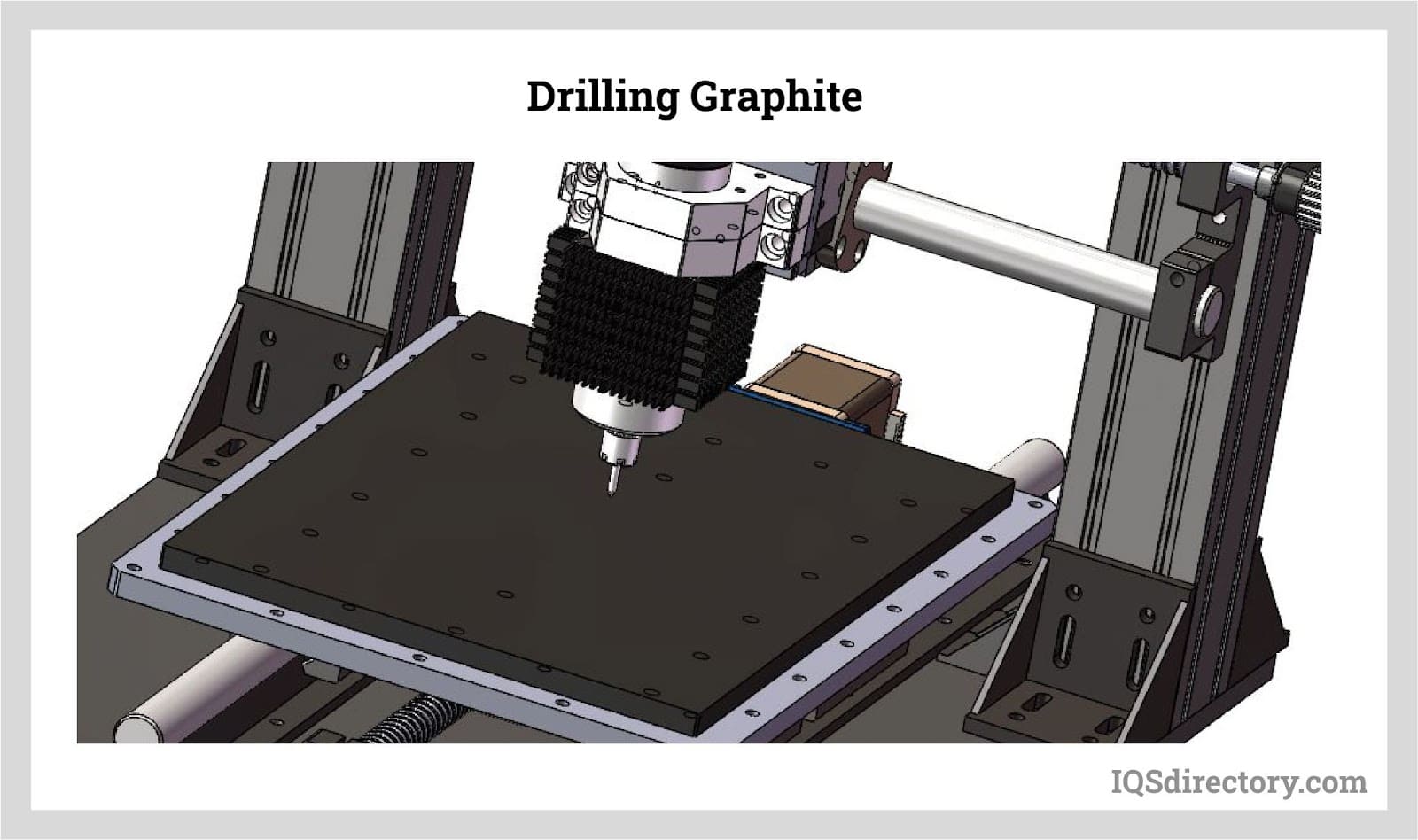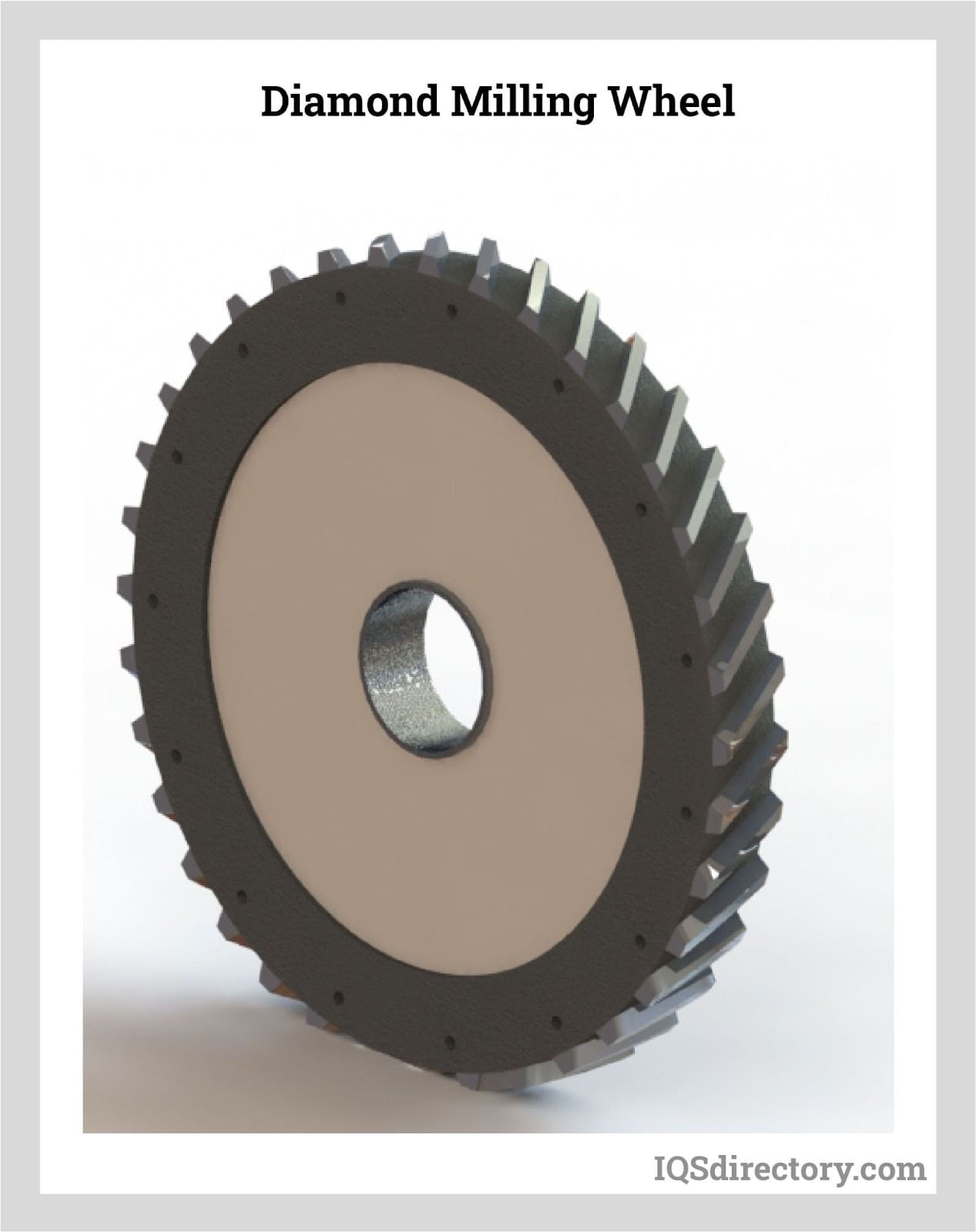Graphite Machining
Graphite is one of the strongest minerals in the world, widely used across industrial production in everything from #2 pencils to EDM (Electrical Discharge Machining equipment. Its exceptional strength and durability have made it a staple material in factories and heavy machinery, often outperforming plain steel and other carbon-based composites. However, graphite in its raw state is not suitable for direct industrial use. To be functional, it must first undergo machining.
Graphite machining is the process of cutting or shaping graphite to meet the specifications of various applications. The raw material is so hard and abrasive that it can dull most metals, making it essential to use only diamond or carbide tools during the machining process. Despite this challenge, graphite offers numerous advantages. It does not rust or degrade, is incredibly resilient, and acts as a natural lubricant—ideal for bearings and other moving parts in machinery. This lubricating quality can significantly reduce the need for additional oils and lubricants, helping to lower maintenance costs and extend equipment life.
Graphite Machining FAQs
What is graphite machining used for in industrial applications?
Graphite machining is used to cut, shape, and refine graphite into components for CNC milling, EDM, and foundry operations. These machined parts are essential in manufacturing electrodes, bearings, crucibles, and molds due to graphite’s strength, conductivity, and heat resistance.
Why are diamond or carbide tools required for machining graphite?
Graphite is extremely hard and abrasive, which quickly dulls most metals. To ensure precision and durability, machinists use diamond or carbide tools, allowing them to maintain sharpness and produce clean, accurate cuts in the material.
What are the main methods used to machine powdered graphite?
Powdered graphite is machined using methods such as compression molding, isostatic molding, vibration molding, die molding, and extrusion. Each technique shapes graphite powder under heat and pressure to form dense, durable components suited to industrial specifications.
What makes isostatic graphite unique compared to other forms?
Isostatic graphite is created by compacting graphite powder uniformly from all directions, producing a dense, isotropic material with fine grain and consistent properties. Its uniformity and strength make it ideal for high-precision manufacturing and advanced industrial components.
How is graphite used in EDM machining?
In electrical discharge machining (EDM), graphite serves as a key electrode material. Its high electrical conductivity and low wear rate enable precise metal removal, improving machining speed and efficiency for complex metal components in U.S. manufacturing operations.
What are the advantages of using graphite bearings and bushings?
Graphite bearings and bushings are self-lubricating and resistant to wear, eliminating the need for added oils or greases. They reduce maintenance costs and enhance machinery lifespan, making them popular in heavy-duty industrial environments across North America.
How do natural and synthetic graphite differ in production and use?
Natural graphite is mined from ore deposits and appears as flakes, plates, or lumps. Synthetic graphite is lab-produced from petroleum-based materials, offering enhanced electrical and thermal conductivity ideal for advanced applications like batteries and high-temperature systems.
History of Graphite
The earliest known use of graphite was in the production of pencil leads, with the first examples of graphite machining appearing in the sixteenth century. During this period, a particularly solid deposit of graphite was discovered in England and cut into sticks for drawing and marking. While that specific deposit was notable for its purity, graphite itself is a widely occurring mineral and was soon found in other regions. Today, India and China are the largest producers of natural graphite, while the United States leads in the production of synthetic graphite.
One of the first individuals to explore the modern potential of graphite was Joseph Dixon, who would go on to found the Dixon-Ticonderoga pencil company. Dixon recognized graphite’s usefulness as a lubricant, particularly in foundries and machinery requiring bearings. He also identified its potential for use in brake linings. His graphite crucibles became essential tools for producing metal, especially for manufacturing firearms and ammunition during the Civil War. Meanwhile, the pencils he developed gained popularity on the battlefield, offering soldiers a more portable and practical means of writing compared to the bulky pens and inkwells of the time.
The earliest graphite processing techniques employed by Dixon and his contemporaries primarily relied on shaping the material using heat and pressure, as seen in compression molding methods. At the time Dixon discovered his graphite source, the demand for crucibles was especially high due to the war’s increased need for bullets and arms production. After the Civil War, the applications of graphite broadened significantly, creating a need for more advanced machining processes.
Historically, when solid chunks of graphite were available—like the ones used in early pencil making—they could be cut and shaped with basic saws. Today, however, machining technology has evolved dramatically. Sophisticated methods allow for the production of precise and complex graphite forms, including advanced materials such as isostatic graphite and graphene. These are now created through a combination of physical and chemical processes. With the introduction of CNC miling, hydraulics, and other precision tools, manufacturers are able to achieve far greater control, efficiency, and refinement in the production of graphite-based components and materials.
How Graphite is Machined
To manufacture graphite shapes and bricks, the primary ingredient is graphite itself. Often, additives such as aluminum or carbon fiber are mixed into the graphite during molding or extrusion to enhance its properties—adding durability or modifying its electrical and thermal conductivity thresholds. These enhanced graphite materials are commonly used in processes like EDM (electrical discharge machining), where graphite serves a crucial role in the production of electrodes. Some machining shops are also equipped to create wire EDM components, which help insulate electrical systems from discharge, a critical function in protecting delicate machines during operation. In manufacturing, EDM is vital for preventing electrical overloads, particularly in CNC milling and other high-precision machining applications. Another specialized form, pyrolytic graphite, exhibits unique thermal conductivity properties—heat moves across the width of the sheet more efficiently than it moves through its thickness.
Graphite is widely used in industrial applications such as CNC machining and EDM due to its exceptional strength. It represents the most stable form of carbon found in nature and consists of layers made up of graphene—a material that can be separated from the graphite and used independently. Graphene itself is even stronger than graphite and conducts both heat and electricity with remarkable efficiency. The process of exfoliation allows graphene layers to be isolated by peeling them from the graphite using a strong adhesive. This conductivity, already impressive, can be further enhanced through the inclusion of additional metals, as mentioned earlier.
To create usable components, graphite must be machined, starting with the transformation of mined or synthesized graphite into a powder. This powder is then processed through advanced machining techniques to form industrial parts. Graphite's excellent thermal and electrical properties—especially in EDM and other precision applications—have made both natural graphite and carbon graphite highly sought after in numerous industries. Machining centers employ state-of-the-art equipment to carry out this transformation, ensuring that graphite powder is shaped into essential components used throughout modern manufacturing.
The machining of graphite follows a two-stage process. First, raw graphite must be broken down into a fine powder. This can originate from natural flake graphite or lab-created molded graphite. The most common method of producing graphite powder is by crushing these flakes into a fine, uniform consistency. Once powdered, the second stage begins—machining that powder into the final product.
There are five principal methods used to machine powdered graphite, each beginning with the same base material. One approach is compression molding, where the powder is heated and allowed to expand thermodynamically within a sealed mold. Another method is isostatic molding, in which graphite is compacted inside a rubber bag and pressurized from all directions, making the resulting graphite isotropic. This isostatic graphite is both fine-grained and unusually dense, making it a high-demand material for precision manufacturing where consistency is critical.
A third method, vibration molding, involves shaking containers at high speeds to compact the powder, often in combination with hydraulic compression to improve product stability. In die molding, graphite powder is compressed into thin sheets and shaped by punching desired forms from the compressed material. The final method, extrusion, pushes the graphite powder through a shaped die to create continuous lengths of graphite with uniform cross-sections.
To begin the machining process, manufacturers require detailed specifications. These are usually provided in modeling software such as CAD, which outlines the precise dimensions and properties of the desired part. If a specific type of graphite—such as isostatic graphite—is required, this will be clearly noted in the design specifications so machinists can choose the correct process. From there, the appropriate molding technique is selected, and the graphite is formed into the final product according to the customer’s needs.
Graphite Machining Images, Diagrams and Visual Concepts
 Graphite machining, a method for shaping, forming, configuring, and cutting graphite material to produce parts and components.
Graphite machining, a method for shaping, forming, configuring, and cutting graphite material to produce parts and components.
 Molding process for graphite machining produces components with similar properties made by isostatic pressing.
Molding process for graphite machining produces components with similar properties made by isostatic pressing.
 A graphite crucible, a container used for melting and casting non-ferrous non-iron metals.
A graphite crucible, a container used for melting and casting non-ferrous non-iron metals.
 Drilling into graphite requires a higher spindle speed and a diamond coated drill bit with no limitations on hole size.
Drilling into graphite requires a higher spindle speed and a diamond coated drill bit with no limitations on hole size.
 One of the specialized tools with diamond edges to machine the material.
One of the specialized tools with diamond edges to machine the material.
Graphite Machining Types
-
Carbon Graphite
Used in mechanical applications for its strength and hardness. While durable, carbon graphite offers lower heat resistance and conductivity compared to pure graphite, making it suitable for specific environments where those properties are less critical.
Extruded Graphite
Characterized by a relatively fine grain size and favorable mechanical, electrical, and thermal properties. It features a preferential grain orientation and low ash content. Further impregnation can enhance its density, mechanical strength, and oxidation resistance.
EDM Graphite
A key material in electrical discharge machining (EDM). It reduces wear on electrodes and enables fast, efficient metal removal, making it a preferred choice for precision tooling.
Graphite Bearings
Commonly used alongside graphite bushings in load-bearing systems. They offer self-lubricating properties and high durability under varying operating conditions.
Graphite Composites
Valued for being lightweight yet strong and durable. These composites are widely applied in the automotive, aerospace, and aviation sectors to provide structural reinforcement and reduce overall weight.
Graphite Crucibles
Serve as containers for holding materials and samples during high-temperature fusion and mixing processes. Their thermal stability and chemical resistance make them essential in metallurgy and materials research.
Graphite Design
Refers to the production of a wide array of components manufactured through precision machining of graphite materials, tailored for industrial and commercial use.
Graphite Electrodes
Used extensively in ladle furnaces and electric arc furnaces. Known for their high electrical conductivity and stability under extreme temperatures, they are crucial in steelmaking and foundry operations.
Graphite Fixtures
Include packaging and sealing fixtures used in automated systems and the semiconductor industry. These fixtures offer high thermal resistance and structural stability in precision environments.
Graphite Machining
The fabrication process through which synthetic graphite materials are shaped into specific components using advanced techniques like CNC milling or EDM.
Graphite Rods
Applied in the fiber optics and semiconductor sectors for manufacturing components such as dies, spindles, and chucks. Their precision and conductivity make them suitable for high-tech applications.
Graphite Tubes
Used in furnace systems due to graphite’s low heat sensitivity and stability at high temperatures. They also serve in the production of fluxing tubes for the metal industry, and find use in chemical and scientific research settings.
Isostatically Pressed Graphite
A dense, isotropic graphite with extremely fine grain, produced through isostatic pressing. This material is capable of being formed in large dimensions and is valued for its consistency and superior performance.
Physical Composition of Graphite
Graphite exists in both natural and synthetic forms. Natural graphite is sourced from ore deposits and occurs in three primary forms: flakes, plates, and lumps. Flake and plate graphite can be extracted through either pit mining or underground mining methods, while lump graphite is exclusively obtained via underground mining. The specific form of graphite present in an ore deposit depends on the geological conditions under which it formed—typically the same conditions responsible for the formation of coal.
In addition to mining, humans have developed methods to produce graphite artificially in laboratory settings. Synthetic graphite is derived from petroleum-based materials and can be combined with carbon to create enhanced versions of the mineral. These synthetic forms often offer improved thermal and electrical conductivity, making them especially valuable in advanced industrial applications.
Production Utilizations for Graphite
Graphite can be used across a wide range of industries and applications. Machined graphite plays a key role in producing components such as degassing tubes, cathodic protection anodes, packing rings, thrust washers, brazing fixtures, boards, and pillow blocks. One reason graphite machining is so widespread is the remarkable nature of graphite itself. It’s a highly durable material with a long service life, and its ability to be reused multiple times only enhances its appeal. Much of the credit goes to the graphite production industry, which has long prioritized sustainability. Through recycling and material recovery efforts, graphite production has become increasingly eco-friendly—a significant advantage in today’s environmentally conscious market.
Once machining is complete, graphite products and graphite-carbon compounds are used in a wide variety of industries. In metallurgy, graphite is widely utilized for its heat resistance, particularly in the manufacture of anodes for smelting. Graphite tubes are also employed in fluxing applications. In the chemical industry, graphite’s ability to withstand extreme temperatures and corrosive environments makes it ideal for heating systems and chemical processing operations. Graphite components are also used in industrial furnaces and commercial heating systems, especially where precision and stability are required.
Beyond durability, graphite is prized for its excellent electrical conductivity. Graphite electrodes are widely used to prevent buildup in machines and support efficient energy transfer. As industrial technology has advanced, the value of graphite in electrical discharge machining (EDM) and CNC machining environments has only increased. In these settings, graphite-carbon electrodes are relied upon for their ability to carry and dissipate electrical energy. Additionally, graphite can be formed into rods or rings for use in heating elements and even plays a role in pharmaceutical manufacturing processes. One of graphite’s earliest industrial applications—crucibles and solid plates—continues to see use today, tracing back to the Civil War era.
Before the 1900s, graphite crucibles dominated the market as containers for molten metals during smelting and forming. As the twentieth century progressed, the industry shifted toward more advanced graphite shapes and molded bricks. Today, custom-formed graphite shapes are the most widely produced graphite products, while bricks and crucibles have become more specialized in their use.
Graphite is also a critical component in modern battery technology, particularly in lithium-ion batteries. With the growth of mobile devices and the rapid rise of electric vehicles, demand for lithium batteries—and by extension, graphite—has surged. In the steel industry, graphite is used as a carbon additive during the final stages of smelting. This process, known as carbon raising, is highly competitive and represents one of the primary applications for synthetic graphite dust.
In the automotive sector, graphite serves a variety of roles: it's used in brake components, acts as a lubricant for molds in foundries (often in powder form), and continues to be the material of choice for the tips of lead pencils—a testament to graphite’s enduring versatility across both traditional and cutting-edge technologies.
How to Choose the Right Graphite Machining Manufacturer for You
When selecting a manufacturer, there are several key considerations to keep in mind. One of the first is determining which graphite machining process your project requires. It’s essential to ensure that the design and specification software you use is compatible with your manufacturer’s preferred platforms, as this can greatly streamline communication and prevent costly delays. While many manufacturers are fully capable of machining graphite with efficiency and precision, it’s equally important to choose a partner you can work with comfortably—one that values collaboration and is responsive to your specific goals.
Given that graphite machining involves five distinct processes to reach a finished product, not every manufacturer will have the equipment or expertise to perform all of them. If your application demands a specialized process such as isostatic molding or another advanced method, it’s critical to confirm that the manufacturer you choose can support those exact requirements. Aligning your project’s needs with the manufacturer’s capabilities ensures both a smoother production experience and a higher quality outcome.
Graphite Machining Terms
-
Angstrofine
The most advanced grade of EDM graphite, Angstrofine is chosen for applications requiring fine detail and exceptionally smooth surface finishes.
Billet
An uncut graphite block produced by the manufacturer, typically ranging from two to seven square inches. Billets are often used for longer or larger-scale machining projects.
Breakthrough
The point at which a through-hole cavity is completed, marking the exit end of the hole during machining.
Carbon
A naturally abundant element and the fundamental component of graphite. The terms "carbon" and "graphite" are sometimes used interchangeably, though graphite is a specific crystalline form of carbon.
Coke
A processed form of coal used as a carbon source. Processed coke is stronger and burns more consistently than metallurgical coke.
Composite
A material composed of two or more combined substances. An example is copper graphite, a composite of metallic and carbon elements used in various industrial applications.
EDM (Electrical Discharge Machining)
A non-traditional machining method where metal is removed from a workpiece through electrical erosion rather than cutting.
Electrode
A key tool in EDM that carries electrical current and mirrors the desired shape to be machined into the workpiece. Electrodes must be conductive to function effectively.
Filler
Carbon-based particles used in manufactured graphite, forming the aggregate foundation of an unbaked green-mix formula.
Flash
A thin, excess ridge or web of metal that extends beyond a casting’s intended shape, often resulting from poor mold contact along the joint line.
Grain
A distinct region within a carbon or graphite body, identifiable as originating from an individual particle of filler.
Horn Gate
A curved gate in the shape of a horn that directs molten metal into the bottom of a casting cavity, facilitating even and controlled flow.
Isotropic
A material property indicating uniformity in all directions. Isotropic graphite exhibits consistent characteristics regardless of testing orientation.
Machined
A term describing a product that has been shaped, cut, or finished using mechanical tools or equipment.
Premium Graphite
A high-quality graphite grade characterized by a fine particle size of five microns or less, offering superior detail and performance.
Transducer
A device that converts one form of energy into another. In EDM, transducers convert electromagnetic energy into mechanical energy for machining graphite. Although this process produces sound, it is often at a frequency beyond the range of human hearing.
Trim Die
A die used to shear or trim excess material from a workpiece, shaping it to precise specifications.
Workpiece
The material being machined. It undergoes various operations until it replicates the design or form of the intended final component.
Graphite Molds
Used in a variety of industrial applications, graphite molds are ideal for manufacturing processes that involve permanent molding. Their widespread use is due to graphite’s extremely high melting point—approximately 4200 K, or 6,422 degrees Fahrenheit—making them highly resistant to thermal stress.